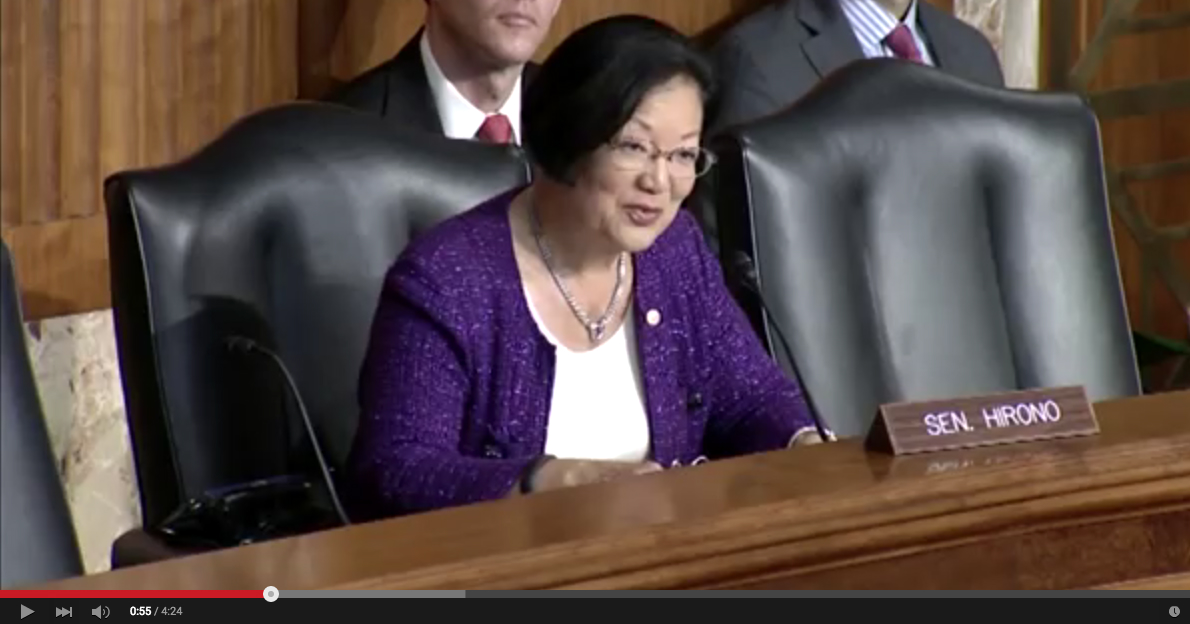Hirono Touts Hawaii’s Renewable Energy Goal At Senate Hearing On Island Energy
WASHINGTON, D.C.- This morning, Senator Mazie K. Hirono spoke about the importance of finding renewable energy solutions for island states and communities like Hawaii at a Senate Committee on Energy and Natural Resources hearing on Islanded Energy Systems in Alaska, Hawaii, and the U.S. Territories. Senator Hirono heard from stakeholders from Hawaii, Guam, Alaska, and the U.S. Virgin Islands on the unique challenges of meeting the energy needs of island communities.
From Senator Hirono’s opening statement:
“It’s incredibly important that we are holding this hearing on islanded energy systems. The people of Hawaii understand the unique challenges that come with living on our islands, but our energy challenges loom especially large. Families and businesses in Hawaii are well aware that they face the most expensive energy costs in the country.”
Witnesses at the hearing included Hawaii State Energy Office Administrator Mark Glick and Department of Interior Assistant Secretary for Insular Areas Esther Kiaaina. Hawaii currently meets 21 percent of its energy needs through renewable sources, and has pledged to increase that goal to 100 percent by 2045.
Watch Senator Hirono’s opening remarks here:
Senator Hirono’s remarks, as prepared for delivery:
Thank you, Senator Cantwell and Chair Murkowski for allowing me to join you in making some opening remarks.
I’m glad that, Senator Cantwell, you mentioned the high energy costs in Puerto Rico- twice what the national average is. In Hawaii, it is three times the national average and Alaska is well aware. Senator Murkowski, our two states can become test beds for how we can provide affordable and renewable energy to remote areas.
Aloha to my friend Bob Underwood, president of the University of Guam and former delegate to the U.S. House of Representatives. And of course I am really pleased to welcome Mark Glick, the Administrator of Hawaii’s State Energy Office, as one of our witnesses today.
I am also pleased to see Assistant Secretary Esther Kiaaina, another friend, who served as First Deputy for Hawaii’s Department of Land and Natural Resources, among other positions of public service to the state of Hawaii.
It’s incredibly important that we are holding this hearing on islanded energy systems. The people of Hawaii understand the unique challenges that come with living on our islands, but our energy challenges loom especially large. Families and businesses in Hawaii are well aware that they face the most expensive energy costs in the country.
With oil accounting for 80 percent of the energy needs of our state, the people of Hawaii are acutely aware that there must be new alternatives to the volatile prices and vulnerable supply of the global oil trade.
We can address our energy needs in ways that are much cleaner using Hawaii’s own renewable resources.
In 2008, with the advice and support of the Department of Energy, our state established the Hawaii Clean Energy Initiative, a groundbreaking state and federal partnership. We set a goal for 40 percent of our energy to come from renewables by 2030—and in June of this year the Governor of Hawaii signed into law an expansion of that goal to 100 percent renewable electricity by 2045. This is the most ambitious plan and goal in the country. Can we get there? Mr. Glick is here to tell us how we’re going to do that. Hawaii has already more than doubled its use of renewable electricity in six years to 21 percent.
Hawaii also set a goal requiring a 30 percent improvement in energy efficiency by 2030. According to the Hawaii State Energy Office, the standard has resulted in the equivalent of $405 million in energy savings for Hawaii’s homes, farms, and businesses. Hawaii has also established an on-bill financing program to help consumers cut their energy costs by investing in clean energy.
Hawaii has benefited from the partnership of the State, the utilities, and the military in finding solutions for an affordable, lower-carbon energy future. It will help us keep at home more of the $5 billion per year that we currently spend on importing energy. So not paying for importing oil and becoming more energy self-sufficient will of course mean more money circulating in our own economy creating jobs, raising wages, and helping families make ends meet.
It is great that we are focusing today on how Hawaii and other islanded areas deal with the high dependence on oil, high energy prices, and the reduced reliability of energy supply that comes from not being able to connect our electrical grids and pipelines with neighboring states.
At the same time, Hawaii is on the forefront of addressing questions that will need answers all across the states and territories of the U.S.: how to use energy more efficiently in our homes, vehicles, and businesses, how to get affordable energy from increasingly renewable sources, and how to integrate new sources of energy in the energy infrastructure that supports our daily lives.
Thank you. I look forward to the testimony of the witnesses.
